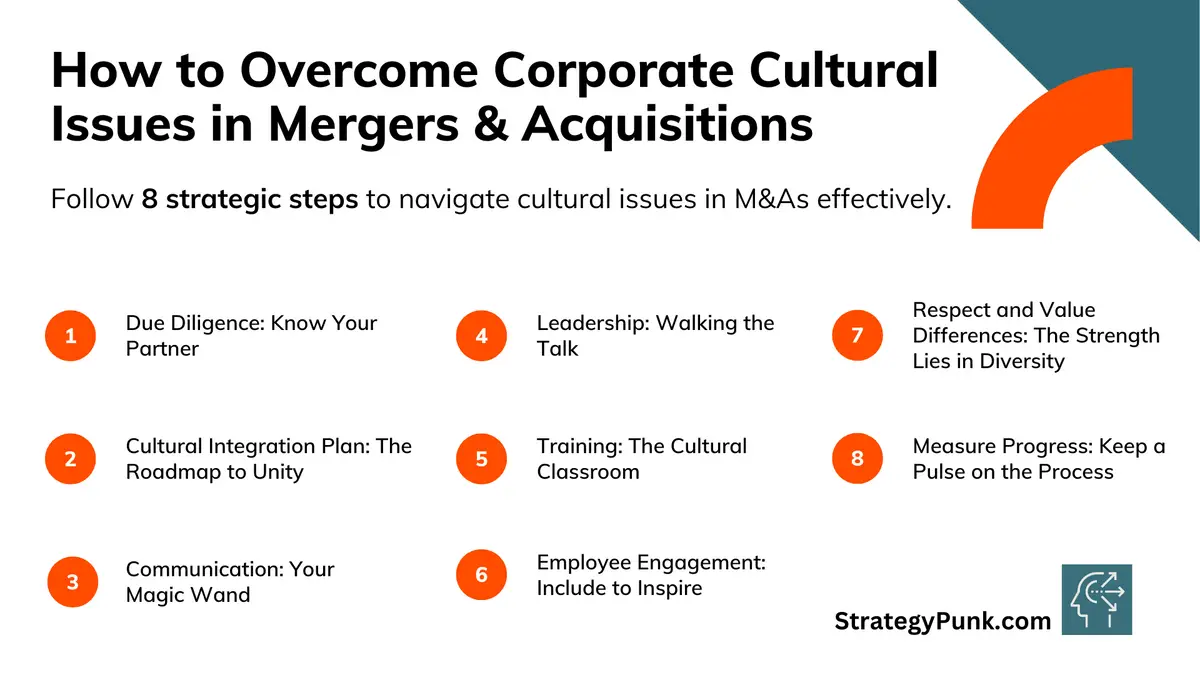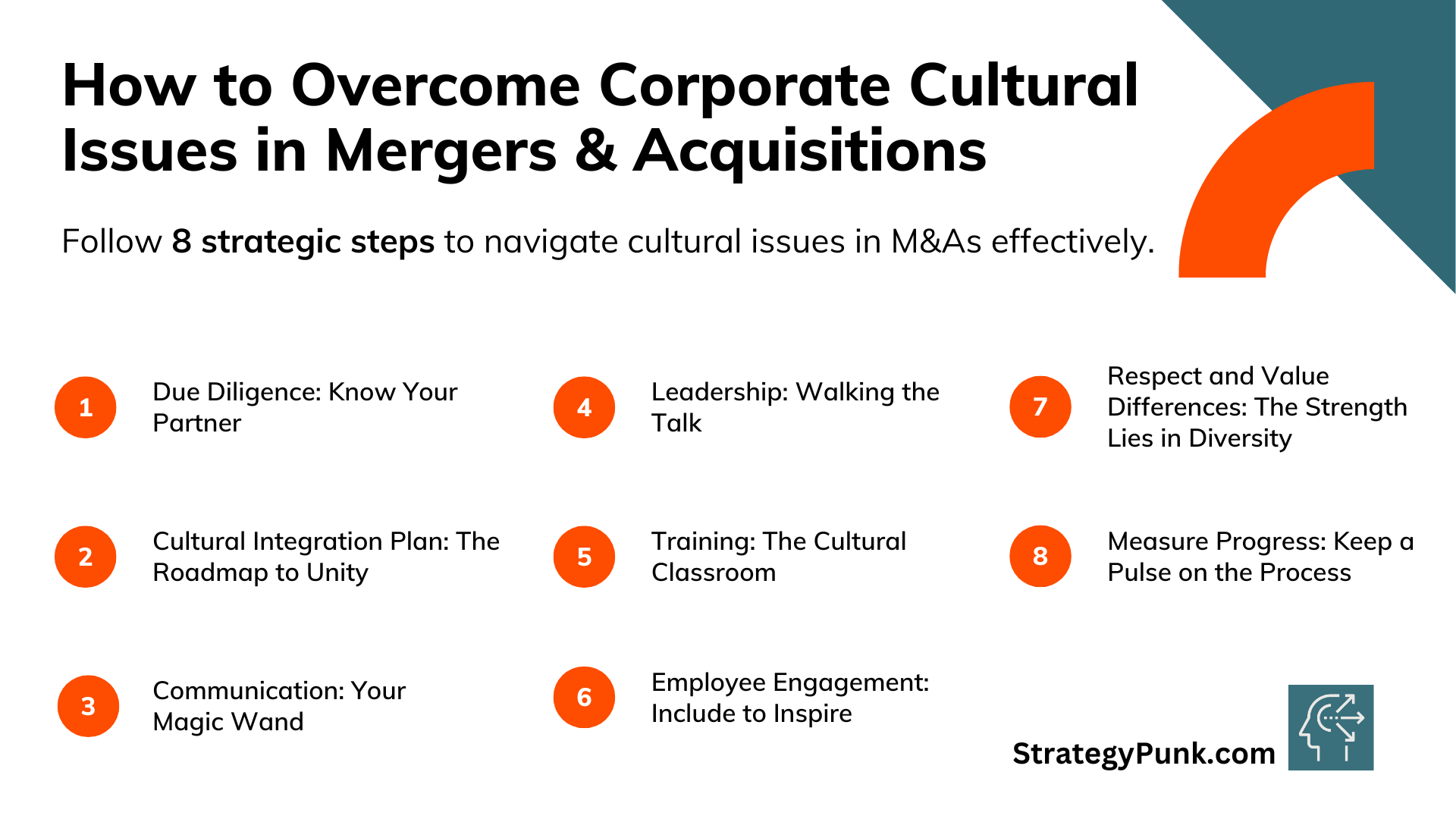How to Overcome Corporate Cultural Issues in Mergers & Acquisitions
Overcome corporate cultural issues in Mergers & Acquisitions with our strategic guide. Discover the roadmap to harmonize diverse cultures, ensure smooth integration, and drive M&A success.

Mergers and Acquisitions (M&As) present a complex tapestry in the corporate landscape. Among the many challenges encountered, the subtle yet pivotal issue of corporate culture often takes center stage.
This cultural facet in M&As can be likened to a finely tuned orchestra. Each organization brings its unique set of notes and rhythms. The artistry lies in harmonizing these diverse elements to produce a symphony that resonates with cohesion and synergy.
The pressing question is how to conduct this orchestra to perfection. This article is your guide.
We will unveil eight strategic steps to navigate cultural issues in M&As effectively.
This critical exploration promises valuable insights for corporate leaders and stakeholders.
So, we invite you to join us in this in-depth analysis.

Due Diligence: Know Your Partner
Just like you wouldn't marry someone without knowing them, you shouldn't merge or acquire without comprehensive due diligence.
This phase should extend beyond finances and legalities to understanding your partner's organizational culture. A thorough cultural assessment can illuminate potential clashes and areas needing focus during integration.
Cultural Integration Plan: The Roadmap to Unity
Developing a clear, strategic cultural integration plan can be the difference between a rough ride and a smooth journey.
This roadmap should articulate how you'll harmoniously blend both companies' values, practices, and behaviors. Remember, it's about creating a beautiful symphony, not a jarring noise!
Communication: Your Magic Wand
Words have power; in M&As, they can spell the difference between success and failure.
Effective, transparent communication about why the M&A is happening, its impact on employees, and the expected cultural changes can significantly reduce resistance. Remember, silence breeds fear, but communication fosters trust.
Leadership: Walking the Talk
Leaders aren't just decision-makers; they're cultural ambassadors during an M&A. They should communicate the shared vision and exemplify the new cultural norms.
When leaders walk the talk, they build a trust bridge that employees are more likely to cross.
Training: The Cultural Classroom
Think of cross-cultural training as the classroom where your employees learn the language of their new culture.
From workshops and seminars to team-building activities, these learning platforms can equip your teams with the skills to understand and adapt to their new environment.
Employee Engagement: Include to Inspire
Want to win your employees' hearts and minds? Involve them in the integration process.
Setting up cross-cultural teams or committees can promote buy-in and minimize resistance. After all, we all like being part of the solution.
Respect and Value Differences: The Strength Lies in Diversity
The beauty of M&As is the merging of two unique entities. Instead of imposing one culture onto another, value the strengths of both.
This mutual respect can lead to a new, combined culture like a diamond - more substantial, brighter, and valuable.
Measure Progress: Keep a Pulse on the Process
Just like a doctor regularly checks a patient's pulse, you should measure your integration progress.
Regular assessments can reveal ongoing issues or resistance points, feeding into strategic adjustments. Remember, what gets measured gets managed.
Executive Summary
In the intricate world of Mergers and Acquisitions (M&As), the critical role of corporate culture cannot be overstated.
Much like a symphony, each organization has its unique notes and rhythms—the success of the merger or acquisition hinges on blending these diverse elements into a harmonious whole.
This article unveils eight strategic steps to navigate and manage the complexities of cultural issues in M&As effectively:
- Comprehensive due diligence to understand the partner's organizational culture.
- A transparent, strategic cultural integration plan to blend both companies' values, practices, and behaviors.
- Effective, transparent communication to reduce resistance.
- Leadership that communicates the shared vision and exemplifies the new cultural norms.
- Cross-cultural training to equip teams with the skills to adapt to their new environment.
- Involving employees in the integration process to promote buy-in and minimize resistance.
- Respect and value the strengths of both cultures to foster mutual respect and create a more robust, combined culture.
- Regular assessments to measure integration progress and make necessary strategic adjustments.
These strategies provide:
- A roadmap for managing cultural issues.
- Ensuring a smoother integration process.
- Enhancing the chances of a successful M&A.
In the dynamic landscape of M&As, understanding and adeptly managing cultural issues can differentiate between a successful merger and an unfortunate misstep. Thus, the path to M&A success lies in financial and operational integration and cultural amalgamation.
Introduction to the PDF Template: 8 Steps to Overcome Corporate Cultural Issues in Mergers & Acquisitions
Welcome to our comprehensive guide on navigating one of the most critical yet often overlooked aspects of Mergers and acquisitions (M&As) - corporate culture.
This PDF template is your one-stop resource, encapsulating eight essential steps to effectively handle and overcome cultural issues in M&As.






